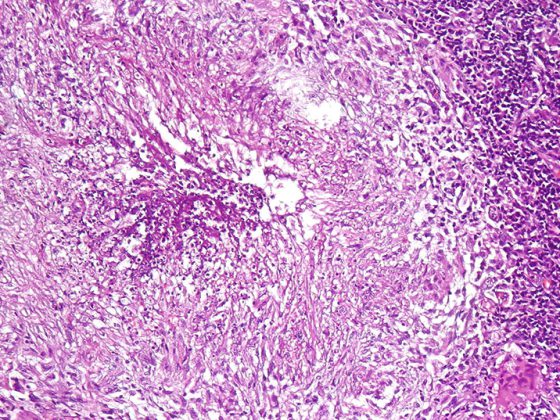Early detection and treatment of renal dysfunction and cardiovascular risk factors in type 2 diabetes mellitus is essential. Experts see a need for action in this area, especially with regard to renal complications. As a solution, they propose multidisciplinary disease management based on the principles of collaborative care and involving actors at different levels.
Currently, around 59 million people in Europe are affected by diabetes. By 2045, this number is expected to increase to 67 million [1]. About 90% of them suffer from type 2 diabetes mellitus (T2DM). If adequate treatment is not provided, these patients are at increased risk for serious health complications such as renal failure and cardiovascular disease, the two leading causes of death in T2DM patients [2,3].
Multidisciplinary integrated care
Nearly one-third of T2DM patients develop cardiovascular disease (CVD) [2] and about 40% develop chronic kidney disease (CKD) [4]. Diabetes is one of the most common causes of end-stage renal failure – in half of the cases it is a diabetic secondary disease [3]. According to current knowledge, renal and cardiac systems influence each other and should not be considered in isolation [5]. Cardiovascular disease is the leading cause of death in adult T2DM patients [2,3]. HbA1c level has a clear association with cardiovascular events [6]. With poorly controlled blood glucose levels, the risk of myocardial infarction is increased by 67%, the risk of stroke is increased by 51%, and the risk of heart failure increases by 64% [3,5]. However, renal complications also affect mortality risk. Albuminuria and reduced eGFR have been shown to have a significant association with mortality [7].
Regular monitoring and timely treatment of cardiovascular and renal risk factors are central themes of the “A New Era in Diabetes Care” initiative launched in February 2020. Diabetes experts in primary and secondary care from across Europe have joined forces to develop strategies to improve the quality of prevention and treatment [8]. T2DM and sequelae impose a great burden both at the individual level and on the healthcare system. In their report, the experts point out that CVD and CKD are highly correlated, and ignoring warning signs of renal complications significantly increases the likelihood of earlier onset of CVD [9]. Well-controlled renal outcomes in patients with T2DM are also associated with improved quality of life and result in a reduced financial burden on the healthcare system [10,11]. Therefore, one conclusion of the authors of the report is that action is needed to improve the detection and early treatment of renal dysfunction in T2DM. As a solution, they propose an action plan that can be implemented in a multidisciplinary treatment context and is based on the idea of collaborative care. The prerequisite is a therapeutic alliance between the patient and the health professional (e.g. physician, nurse, nutritionist, etc.) based on partnership. The procedure is divided into the three phases “measure”, “treat” and “review” with the aim of preventing CKD or preventing worsening of renal function values.
| Diabetes treatment during corona pandemic: telemedicine solutions It is likely that the COVID-19 pandemic will continue to impact health care [8]. Digital innovations/telemedicine can be used to maintain regular review of treatment in diabetic patients when clinical appointments are unnecessary or inappropriate. In the field of patient education and information campaigns, online-based interventions have been standard practice for some time. Examples of successfully implemented projects in this area are TREND-UK (online meetings etc.) [26] and ANODE (e-coaching etc.) [27]. Primary Care Diabetes Europe (PCDE) webinars include T2DM in the context of coronary pandemic (www.pcdeurope.org) [28]. |
Barrier management to optimize control of renal complications.
An analysis of the current status shows that there is a need for action on the following points to improve the prevention and treatment of renal dysfunction in T2DM [8]:
Recognize warning signs of chronic kidney disease (CKD)
The 2019 and 2017 IDF guidelines recommend that diabetic patients (types 1 and 2) be screened annually for CKD by assessing estimated eGFR and urinary albumin creatinine ratio (UACR) [12,13]. In reality, however, this is rarely implemented, as a situation analysis conducted in various European countries shows [8,14–16]. One of the reasons is an underestimation of the impact of CKD on CVD-associated mortality risk [16]. Early diagnosis is a key factor in preventing the onset or worsening of renal impairment, so consistent measurement of UACR should be performed in patients with T2DM [17]. In addition, eGFR values should be collected, for example according to the Chronic Kidney Disease Epidemiology Collaboration Equation (CKD-EPI). The expert panel agrees that the performance of these screening tests are a key factor for the control and treatment of renal function values and renal disease. CKD.
Demonstrate advantages of SGLT-2 inhibitors and GLP-1 receptor agonists.
The T2DM treatment paradigm is still strongly focused on glycemic control and the aspect of renal and cardiovascular complications is sometimes neglected. The expert panel attributes the fact that treatment recommendations regarding SGLT-2 inhibitors and GLP1 receptor agonists (GLP-1-RA) are formulated cautiously in certain guidelines, although it has been repeatedly empirically proven that these substance classes have an additional cardiovascular and renal benefit, to the relatively high costs of these modern antidiabetic drugs. They propose to perform a cost-benefit balance to demonstrate that the use of SGLT-2 inhibitors and GLP-1-RA is also economically worthwhile in the long term when savings from delaying renal failure requiring dialysis and hospitalizations due to renal and/or cardiovascular complications are included. Regarding side effects, experts agree that the cardiovascular and renal benefits clearly outweigh any adverse side effects (e.g., urogenital infections), which are usually minor and easily managed. This assessment is also consistent with several recent evaluations of the efficacy and safety of these drug groups [18–20]. Whereby this has to be checked in the individual case and the treatment has to be adjusted if necessary.
Implement quality management measures
Criteria-driven assessment is needed to continuously improve treatment quality. Actors at different levels should cooperate to this end, both at national and at European and international levels [21]. Particular attention should be paid to the phenomenon of clinical inertia, i.e., a need-based modification of the therapeutic regime [22]. It has been observed that clinical inertia occurs particularly in situations where disease management becomes increasingly complex, such as in patients with T2DM and CKD.
Conduct patient education and information campaigns
Therapy adherence is essential for achieving treatment goals. Glycemic control is a key aspect of disease management of diabetes. In patients with T2DM, lifestyle factors and glucose-lowering medications are important measures to achieve glycemic goals [23]. A secondary analysis showed that adherence to oral antidiabetic drugs decreases massively during the treatment period [24]. Promotion of self-management has been shown to help improve glycemic control, positively influencing one of the strongest predictors of diabetes-related complications [25]. To promote compliance, patient education should include targeted information on HbA1c, blood pressure, and other relevant aspects, as well as information on secondary diseases and how to reduce risks.
Literature:
- IDF Diabetes Atlas Ninth Edition 2019. Available at: www.diabetesatlas.org, last accessed 06.06.2020
- Einarson T, et al: Prevalence of cardiovascular disease in type 2 diabetes: a systematic literature review of scientific evidence from across the world in 2007-2017. Cardiovasc Diabetol 2018; 17(1): 83.
- Tuttle K, et al: Diabetic kidney disease: a report from an ADA Consensus Conference. Diabetes Care 2014; 37(10): 2864-2883.
- Alicic R, Rooney M, Tuttle K: Diabetic Kidney Disease: Challenges, Progress, and Possibilities. Clin J Am Soc Nephrol 2017; 12(12): 2032-2045.
- Ceriello A: “A New Era in Diabetes Care,” Professor Antonio Ceriello, virtual panel discussion, 6/4/2020.
- Svensson E, et al: Early Glycemic Control and Magnitude of HbA1c Reduction Predict Cardiovascular Events and Mortality: Population-Based Cohort Study of 24,752 Metformin Initiators. Diabetes Care 2017; 40: 800-807.
- Afkarian M, et al: Kidney Disease and Increased Mortality Risk in Type 2 Diabetes. J Am Soc Nephrol 2013; 24: 302-308.
- Expert Report: A New Era in Diabetes Care, www.dcvd.org, last accessed 6/6/2020.
- Liu M, et al: Cardiovascular disease and its relationship with chronic kidney disease. Eur Rev Med Pharmacol Sci 2014; 18(19): 2918-2926.
- Trikkalinou A, Papazafiropoulou A, Melidonis A: Type 2 diabetes and quality of life. World J Diabetes 2017; 8(4): 120-129.
- Einarson T, et al: Economic Burden of Cardiovascular Disease in Type 2 Diabetes: A Systematic Review. Value Health 2018; 21(7): 881-890.
- Cosentino F, et al: 2019 ESC Guidelines on diabetes, pre-diabetes, and cardiovascular diseases developed in collaboration with the EASD. Eur Heart J 2020; 41(2): 255-323.
- International Diabetes Federation. Clinical Practice Recommendations. 2017. www.idf.org/e-library, last call 6.6.2020
- Hellemons M, et al: Is albuminuria screening and treatment optimal in patients with type 2 diabetes in primary care? Observational data of the GIANTT cohort. Nephrol Dial Transplant 2013; 28(3): 706-715.
- Annali AMD: Valutazione Degli Indicatori AMD di Qualita Dell’Assistenza Al Diabete in Italia. Available at: https://aemmedi.it, last accessed 6/6/2020
- Napp Pharmaceuticals: Type 2 diabetics miss out on a recommended annual kidney test which can signal irreversible damage that may lead to fatal complications, survey reveals. https://napp.co.uk, last call 6.6.2020
- Zac-Varghese S, Winocour P. Managing diabetic kidney disease. Br Med Bull 2018; 125(1): 55-66.
- Flippas-Ntekouan S, Flippatos T, Elisaf M: SGLT2 inhibitors: are they safe? Postgrad Med 2018; 130(1): 72-82.
- Scheen A: An update on the safety of SGLT2 inhibitors. Expert Opin Drug Saf 2019; 18(4): 295-311.
- Opingari E, Partridge A, Verman S, et al: SGLT2 inhibitors: practical considerations and recommendations for cardiologists. Curr Opin Cardiol 2018; 33(6): 676-682.
- Calsbeek H, et al: Performance measurements in diabetes care: the complex task of selecting quality indicators. Int J Qual Health Care 2013; 25(6): 704-709.
- Reach G, Pechtner V, Gentilella R: Clinical inertia and its impact on treatment intensification in people with type 2 diabetes mellitus. Diabetes Metab 2017; 43(6): 501-511.
- Khunti N, al: Adherence to type 2 diabetes management. Br J Diabetes 2019; 19: 99-104.
- Cramer J: A systematic review of adherence with medications for diabetes. Diabetes Care 2004; 27(5): 1218-1224.
- Chrvala C, Sherr D, Lipman R: Diabetes self-management education of adults with type 2 diabetes mellitus: A systematic review of the effect on glycemic control. Patient Educ Couns 2016; 99(6): 926-943.
- TREND-UK, Training Research and Education for Nurses in Diabetes, https://trend-uk.org, last accessed 6/6/2020.
- Hansel B, et al: A Fully Automated Web-Based Program Improves Lifestyle Habits and HbA1c in Patients With Type 2 Diabetes and Abdominal Obesity: Randomized Trial of Patient E-Coaching Nutritional Support (The ANODE Study). J Med Internet Res 2017; 19(11): e360. doi: 10.2196/jmir.7947.
- PCDE, Primary Care Diabetes Europe, www.pcdeurope.org, last accessed 6.6.2020.
HAUSARZT PRAXIS 2020; 15(7): 30-31











